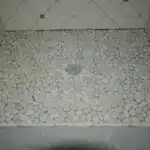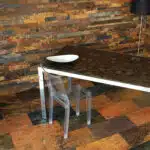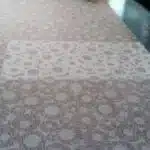Tiling a premade plastic shower pan may seem like a daunting task, especially if you are new to the world of home improvement and DIY projects. However, with the right tools, materials, and techniques, this task can be accomplished with relative ease. In this article, we will guide you through the step-by-step process of tiling a premade plastic shower pan.
A well-tiled shower not only adds aesthetic appeal to your bathroom but also ensures that water does not seep into areas it shouldn’t. While many people opt for professional services to tile their showers, doing it yourself can save you money and give you a sense of accomplishment. With our expert tips and tricks, you’ll be able to transform your plain-looking plastic shower pan into an attractive tiled masterpiece in no time. So grab your tools and let’s get started!
Assessing The Condition Of Your Shower Pan
Like a warrior, your shower pan takes on the brunt of daily battles against dirt and grime. It’s no wonder that over time, it may show signs of wear and tear. Before embarking on your tile installation journey, the first step is to assess the condition of your plastic shower pan.
To begin with, inspecting techniques can vary depending on the type of pan you have. For instance, if there are cracks or chips in the surface, it may be beyond repair. Replacement options should then be considered. On the other hand, if there are only minor stains or discoloration, it’s possible to restore its former glory with a deep clean.
Once you’ve determined that your shower pan is in good enough shape for tiling, gather any necessary tools and materials before proceeding to the next phase of the project. From sponges to tile adhesive and more, having everything you need within reach will help streamline the process and ensure successful results.
Gathering The Necessary Tools And Materials
To begin tiling a premade plastic shower pan, it is essential to gather the necessary tools and materials. The first step is to choose the tile style that will suit your taste and preferences. There are numerous options available in the market, such as porcelain, ceramic, natural stone, or glass tiles. Each material has its unique characteristics and color patterns that can add beauty and value to your bathroom.
Once you have selected the right tile style for your shower pan, it’s time to find affordable tile options. You can check out various home improvement stores or online retailers to compare prices and quality. Keep in mind that some of the cheaper tiles may not be as durable or long-lasting as their more expensive counterparts. Therefore, it’s essential to strike a balance between cost and quality.
In summary, choosing the right tile style and finding affordable options are crucial steps in preparing to tile a premade plastic shower pan. Once you have gathered all the necessary tools and materials for tiling, you can proceed with preparing the shower pan surface for tiling by sanding or filling any cracks or gaps. With careful planning and execution, you can transform your bathroom into a beautiful space with your personalized touch.
Preparing The Shower Pan For Tiling
To properly tile a premade plastic shower pan, it is important to prepare the surface beforehand. One of the most crucial steps in this process is choosing the right tiles. It’s recommended that you opt for ceramic or porcelain tiles as they are durable and water-resistant, making them perfect for use in a shower.
Once you’ve selected your tiles, it’s time to waterproof the shower pan. This involves applying a layer of waterproof membrane over the entire surface area of the pan, including up the walls by about 6 inches. You can use either a liquid or sheet membrane, but both should be applied using a paintbrush or roller.
After waterproofing, it’s essential to allow ample time for the membrane to dry before laying down any tiles. This will ensure that moisture doesn’t seep through and damage your new tiles. By taking these necessary precautions before tiling your premade plastic shower pan, you can ensure that your installation lasts for years to come and provides a watertight barrier against any leaks or damages.
As you move on to measuring and marking the tile placement on your shower pan, keep in mind that accuracy is key to achieving an even and professional-looking finish. Follow our next section carefully for tips on how to measure and mark out your tile placements accurately without damaging your newly prepared surface.
Measuring And Marking The Tile Placement
- Accurately measuring the room is essential for establishing the correct layout when tiling a premade plastic shower pan.
- Establishing the layout of the tiles is best done by using a chalk line, which will help ensure a horizontal, straight line to determine where the cut tiles will be needed.
- When measuring the walls, it is important to measure from the floor up, noting any irregularities and marking them on the wall.
- After the walls have been measured, the tiles should be dry-laid in order to get an idea of the placement and how the tiles should fit.
- Marking the placement points on the tiles is especially important for maintaining the desired layout and for cutting the tiles to fit any irregularities in the wall.
- Once the tile placement points have been marked, the installation process can begin and the tiles can be adhered to the shower pan.
Measuring Room
Achieving a successful tiling project starts with proper measuring accuracy. Especially when it comes to tiling a premade plastic shower pan, precision is key to ensuring that the tiles are cut and placed correctly. Measuring the room beforehand is the first step towards achieving this accuracy.
To start, measure the length and width of your shower pan, making sure to account for any curved corners or angles. This will help you determine how many tiles you need and what size they should be. Choosing appropriate tile size is important to ensure that your tiles fit perfectly in place without any significant gaps or overlapping edges.
Once you have measured your shower pan and determined the appropriate tile size, you can then start planning out the placement of each tile. Use a chalk line or laser level to mark where each tile will go, starting from the bottom row and working your way up. By properly measuring and marking the placement of each tile, you can achieve a beautiful and long-lasting tiled shower that will add value to your home for years to come.
Establishing Layout
Now that you have measured and marked the placement of each tile, the next step is to establish the layout. Choosing tile design is important as it can make or break the overall look of your shower. When selecting tiles, consider the design of your bathroom, color scheme, and personal taste. The right tile selection can accentuate the features of your bathroom while creating a cohesive look.
When establishing layout, it’s crucial to ensure that all tiles are aligned correctly. Use a level to ensure that each tile is at a uniform height, and double-check for any variations in spacing. This will help prevent any uneven tiling or misaligned tiles that may compromise the integrity of your shower. Additionally, consider using an adhesive mat instead of traditional mortar to make installation easier.
Design considerations also include patterns and accents. You can create a unique pattern by alternating different colored tiles or arranging them in a specific order. Adding accents such as border tiles or mosaics can create focal points or add visual interest to your shower as well. By thoughtfully establishing layout and incorporating design considerations, you can achieve a beautiful tiled shower that enhances both form and function in your home.
Marking Placement Points
When it comes to tiling a shower, measuring and marking the tile placement is just the first step. Once you have measured and marked the placement of each tile, the next crucial step is to mark placement points. This involves using measuring tools such as chalk lines or laser levels to ensure that your tiles are evenly spaced and aligned correctly.
One effective technique for marking placement points is to use tile spacers. These small plastic pieces are placed between tiles during installation, ensuring consistent spacing and helping to prevent any misaligned tiles. It’s important not to skimp on this step, as uneven or poorly spaced tiles can compromise both the appearance and functionality of your shower.
Another helpful technique is to establish a pattern for your tiles before beginning installation. This can be done by laying out your tiles in a specific order or alternating different colored tiles. By thoughtfully considering both spacing techniques and design considerations, you can create a beautiful tiled shower that enhances both the form and function of your bathroom space.
Cutting Tiles To Size
One of the essential steps in tiling a premade plastic shower pan is cutting tiles to size. Tile cutting techniques can vary depending on the type of tile you are using, but the most common methods include using a tile cutter or wet saw. When choosing tile sizes, it is crucial to consider the size of your shower pan and how many tiles you will need to cover it.
To cut tiles to size, first measure the dimensions of the area where you will be laying them. Use a pencil and straight edge to mark each tile where it needs to be cut, ensuring that each piece is identical in size. Then, use a tile cutter or wet saw to cut along your marked lines. Remember to wear eye protection when using these tools and follow manufacturer instructions carefully.
When selecting tile sizes for your shower pan, consider both aesthetic and practical factors. A larger tile may look more modern and streamline the design, while smaller tiles may provide better traction and drainage. Additionally, keep in mind that larger tiles may require fewer cuts, which can save time during installation. Choose a size that fits your personal style and meets your functional needs for the space. In the next section, we will discuss how to apply adhesive to the shower pan for successful tiling.
Applying Adhesive To The Shower Pan
After cutting your tiles to size, the next step is to prepare the shower pan for tile installation. This involves applying adhesive to the surface of the pan. Before doing so, it’s important to choose the right type of adhesive for your project. There are several types of adhesives available, including thinset mortar, mastic, and epoxy.
Thinset mortar is a popular choice for shower pan installations because of its durability and strength. It’s also waterproof and resistant to moisture, making it ideal for areas that are frequently exposed to water. Mastic, on the other hand, is a pre-mixed adhesive that is easy to apply and dries quickly. However, it’s not recommended for use in wet areas like showers because it can break down over time when exposed to moisture. Epoxy is another option that provides high strength and durability but can be more difficult to work with than other adhesives.
Proper adhesive application is crucial for a successful tile installation on a plastic shower pan. First, you’ll want to ensure that the surface of the pan is clean and free from any debris or dust before beginning the application process. Then, mix your chosen adhesive according to the manufacturer’s instructions and apply it evenly using a trowel or notched spreader. Be sure not to apply too much adhesive at once as this can cause unevenness in your tile layout.
In summary, choosing the right type of adhesive and applying it properly are essential steps in tiling a premade plastic shower pan. Thinset mortar is often recommended for its strength and waterproof properties while mastic should be avoided in wet areas like showers. Once you have selected your adhesive of choice, take care to apply it evenly using a trowel or notched spreader before moving on to laying the first row of tiles.
Laying The First Row Of Tiles
Before laying the tiles, ensure that the shower pan is clean and dry. This will prevent any dirt or moisture from interfering with the adhesive and tile placement. Begin by applying a layer of thin-set mortar to the bottom of the shower pan using a notched trowel. Work in small sections to avoid drying out before laying down tiles.
Once you’ve applied the thin-set mortar, it’s time to lay down your first row of tiles. Start at one end of the shower pan and work your way across, placing each tile on top of the mortar with a slight twisting motion to ensure it adheres properly. Remember to use tile spacers to maintain even spacing between each tile and cut tiles as needed using appropriate cutting tools.
Properly spacing your tiles is crucial for ensuring a professional-looking finish. Use tile spacers to keep each tile evenly spaced apart from its neighbors. When it comes time to cut tiles, be sure to use appropriate cutting tools such as a wet saw or snap cutter for best results. With the first row complete, you can now continue with placing subsequent rows of tiles in a similar manner without disrupting previously-laid tiles.
Continuing Tile Placement
As you continue tiling your premade plastic shower pan, it’s important to maintain consistency in your tile layout. Take time to step back and evaluate the overall appearance of your tiling job. Ensure that the tiles are properly aligned, leveled, and spaced out evenly. You can use tile spacers to achieve this uniformity.
Once you’ve completed laying down all the tiles, let them dry completely before proceeding with grout application. Choosing the right grout color is crucial as it will affect the overall aesthetic of your shower pan. Light-colored grout can make a small space appear larger while dark-colored grout can create a more dramatic effect.
- Make sure to wear gloves when handling grout
- Mix the grout according to manufacturer instructions
- Apply the grout in small sections using a rubber float
- Wipe off excess grout with a damp sponge
Now that you’ve finished applying grout, it’s time to move on to cutting tiles for edges and corners. This process requires precision and patience as you need to ensure that each cut fits perfectly into place without any gaps or overlapping edges. Be sure to measure twice and cut once!
Cutting Tiles For Edges And Corners
Tile cutting techniques are essential when tiling a premade plastic shower pan. Edges and corners often require special attention, as they can be tricky to cut and place properly. To ensure a seamless finish, it’s important to use the right tools and techniques.
When cutting tiles for edges and corners, it’s crucial to measure twice and cut once. Use a tile cutter or wet saw to make precise cuts, ensuring that the tiles fit snugly against each other without any gaps. For curved edges, use a tile nipper to carefully chip away at the tile until it fits perfectly into place.
Edge and corner tile placement requires careful attention to detail. Start by applying adhesive to the back of each tile using a notched trowel. Press firmly onto the surface of the shower pan, being sure to leave enough space for grout between each tile. Use spacers between each tile for even spacing and remove any excess adhesive with a damp sponge before allowing the tiles to dry completely.
Transition: With all tiles in place, it’s time to move on to grouting. Grout is used not only for aesthetics but also for sealing joints between tiles, preventing water from seeping through and causing damage.
Grouting The Tiles
To achieve a professional finish when tiling your premade plastic shower pan, you must master the art of grouting. Grouting involves filling the gaps between tiles with a special mixture that hardens and binds them together while preventing water from seeping through. Proper grouting techniques make all the difference in terms of durability, appearance, and maintenance.
When it comes to choosing the right grout for your shower pan, you have several options to consider. Grout color can vary depending on your personal preference and interior design scheme. Neutral colors like beige and gray are popular choices since they complement most tile styles and create a clean look. However, if you want to add a pop of color or create an accent wall, you can opt for brighter hues like blue or green.
Once you’ve selected the right grout color for your plastic shower pan tiles, it’s time to start applying it. Begin by mixing the grout according to manufacturer instructions until you have a smooth paste. Using a rubber float, spread the grout over the tiles at a 45-degree angle, pressing it firmly into the gaps as you go. Work in small sections at a time to avoid drying out or cracking of the material. After completing each section, use a damp sponge to wipe off any excess grout from the surface of the tiles.
As important as it is to apply grout correctly, cleaning up excess residue once it has dried is equally vital in achieving professional results. In our next section on cleaning up excess grout, we will cover some easy steps on how to remove any leftover residue from tile surfaces without damaging them or leaving scratch marks behind. Remember that proper cleaning techniques will ensure your plastic shower pan looks great for years to come!
Cleaning Up Excess Grout
When tiling a premade plastic shower pan, the excess grout must be removed first. This can be done by using a grout saw or a putty knife to scrape away any excess.
After the excess grout has been removed, the grout residue must be cleaned off the tile. This can be done by using a damp sponge or cloth and wiping away any remaining residue.
Once the grout residue has been removed, the grout haze must be cleaned off the tile. This can be done by using a clean, damp cloth and wiping away any remaining haze.
If the grout haze is still present, a grout haze remover can be used to clean the tile. This should be used according to the manufacturer’s instructions on the container.
Removing Grout Residue
Removing grout residue is an essential step in the process of tiling a shower pan. Failure to do so can result in unsightly stains and discoloration that may be difficult to remove later on. To start, use a clean sponge and water to wipe down the tiles immediately after applying grout. This will prevent excess residue from drying and hardening on the surface, which can be challenging to remove.
Preventing grout haze is another crucial aspect of removing grout residue. Grout haze refers to the thin layer of excess grout that remains on the surface of the tiles after installation. To avoid this issue, it is recommended that you wipe down each tile with a damp cloth or sponge as soon as possible after applying grout. You should also use a high-quality sealer on your tiles before grouting to prevent the penetration of grout into your tiles’ pores.
Finally, if you still notice some stubborn residue remaining after wiping down the tiles, there are several specialized cleaners you can use. These cleaners contain strong acids that dissolve any remaining residue without damaging your tiles’ surfaces. However, it is important to follow all safety precautions when using these cleaners and wear protective gear such as gloves and goggles. With these tips in mind, removing grout residue will be a breeze, leaving you with beautiful and long-lasting tiled shower pan!
Cleaning Grout Haze
After removing excess grout from your shower pan, you may still notice a thin layer of haze on the surface of your tiles. This is known as grout haze, and it can be unsightly and difficult to remove if left unaddressed. To prevent haze buildup, it is crucial to wipe down each tile with a damp cloth or sponge immediately after applying grout. Doing so will ensure that any excess grout does not dry on the surface and leave behind a residue.
If you do notice haze on your tiles after they have dried, there are several methods for removing it. One effective way to remove haze is by using a specialized cleaner designed explicitly for this purpose. These cleaners contain mild acids that dissolve any remaining grout residue without damaging your tiles’ surfaces. However, it is crucial to follow all safety precautions when using these cleaners and wear protective gear such as gloves and goggles.
Another method for removing haze involves using a mixture of vinegar and water. Simply mix equal parts vinegar and water in a spray bottle, then spray the solution onto the affected tiles. Allow the solution to sit for several minutes before wiping down the tiles with a clean sponge or cloth. This method is safe and effective but may require more elbow grease than using a specialized cleaner. By following these tips, you can successfully remove grout haze from your shower pan and enjoy beautiful, clean tiles!
Applying Sealant
To ensure that your newly tiled plastic shower pan is leak-proof, it’s important to apply an appropriate sealant. Choosing the right sealant can make a significant difference in the durability and longevity of your tiles, as well as prevent water damage. Silicone or urethane-based sealants are recommended for their resistance to mold and mildew, flexibility, and waterproof properties.
Before applying sealant, make sure the surface of your tiles is clean and dry. Any debris or moisture can hinder the effectiveness of the sealant. Use a mild detergent and water solution to clean off any dirt or grime from the surface of the tiles. Once you’ve cleaned them thoroughly, allow them to dry completely before beginning to apply sealant.
Tips for smooth sealant application include using a caulk gun for better control over the amount of sealant applied, cutting the nozzle tip at an angle for a smoother application, and working in small sections at a time so that you can smooth out each section before moving onto another. Start at one corner of your shower pan and work your way around, ensuring full coverage along each joint. Remember to remove any excess sealant with a damp cloth as you go.
After applying your chosen sealant, it’s crucial to let it set and dry according to the manufacturer’s instructions. This will ensure that it has fully cured before exposing it to water or other elements. Once fully dried, you can move on to tiling the rest of your shower pan with confidence that it will be protected from leaks for years to come.
Letting The Tiles Set And Dry
After properly applying the sealant on your shower pan, you can now proceed to tiling. Tiling a premade plastic shower pan is not as difficult as it seems. With proper preparation and attention to detail, you can create a beautiful tiled surface that will last for years.
Before starting, make sure that the surface of the shower pan is completely dry. This is crucial in ensuring that the tiles adhere well and do not shift during installation. You can use a fan or open windows to promote proper ventilation and speed up the drying process. Additionally, laying out all your materials beforehand can help make the installation process faster and smoother.
After laying out the tiles on your shower pan, let them set for at least 24 hours before grouting. During this time, it’s important to keep proper ventilation in mind to ensure faster drying of both the tiles and adhesive. Once fully dried, you can then move on to grouting and sealing your newly-tiled shower floor. Remember that taking your time during each step of the process will ultimately lead to a beautifully tiled shower that you will enjoy for years to come.
Enjoying Your Newly Tiled Shower
- Cleaning and maintaining a newly tiled shower is important in order to ensure that the tiles remain in optimal condition.
- Regularly wiping down the tiles with a damp cloth and mild detergent can help to prevent the build-up of soap scum and other debris.
- Adding accessories like a corner shelf or a shower caddy can increase the usability of the shower, as well as improve the overall aesthetic.
- When installing a premade plastic shower pan, ensure that it is properly secured to the wall, and that the grout lines are sealed for added protection.
Cleaning And Maintaining
Keeping a clean and well-maintained shower is essential to enjoy your newly tiled shower. Cleaning techniques depend on the type of tiles you have used, but there are a few general guidelines you can follow. To start with, use a mild cleaner that is specially formulated for bathroom tiles. Avoid using harsh chemicals as they can damage the tile surface in the long run. You should also avoid using abrasive scrubbers as they can scratch the surface of your tiles.
If you have natural stone tiles, you need to be extra careful while cleaning them. Acidic cleaners or vinegar-based solutions can damage the surface of your natural stone tiles. Instead, use a pH-neutral cleaner that is specifically designed for natural stone surfaces. You should also seal your natural stone tiles periodically to protect them from stains and moisture.
When it comes to maintaining your shower tiles, prevention is key. You can use a squeegee after every shower to prevent soap scum buildup and water spots on your tiles and glass doors. Regularly inspecting your grout lines and caulking around the edges of your shower pan will help you identify any mold or mildew growth early on. If you do notice any mold or mildew growth, use a bleach solution or a commercial mold remover product recommended by a professional to get rid of it quickly.
In summary, keeping your newly tiled shower clean and well-maintained requires some effort on your part, but it’s worth it in the long run. Use appropriate cleaning techniques based on the type of tile you have used in your shower and invest in quality cleaning products recommended by professionals in this field. Prevention is key when it comes to maintaining your shower tiles so make sure to take necessary precautions like regularly inspecting grout lines and caulking around edges of your shower pan to keep them looking their best for years to come!
Adding Accessories
Now that you have a clean and well-maintained newly tiled shower, it’s time to add some accessories to complete the look. Choosing accessories for your shower can be overwhelming as there are so many options available in the market. However, it’s important to keep in mind that the accessories you choose should not only enhance the aesthetic appeal of your shower but also serve a practical purpose.
When choosing accessories for your newly tiled shower, consider adding items that will make your daily routine more convenient and efficient. For instance, a built-in soap dish or shampoo niche can keep your toiletries organized and easily accessible while you’re taking a shower. Installing towel bars or hooks can also help keep your towels off the floor and within reach when you need them.
Once you’ve chosen the right accessories for your newly tiled shower, it’s important to maintain them properly to ensure they last for years to come. Regularly cleaning and wiping down these items with mild cleaners will help prevent hard water stains and soap scum buildup. Additionally, inspecting these accessories periodically for any signs of wear and tear will help you identify any issues early on and address them promptly. By following these maintenance tips, you can enjoy your newly tiled shower with all its beautiful accessories for years to come!
Troubleshooting Common Tiling Issues
Common mistakes can occur during the tiling process that can lead to unsightly and uneven tiles. One common mistake is not properly preparing the surface before tiling. This can cause the tile adhesive to not adhere properly, leading to loose tiles or even complete failure of the tiling job. To avoid this issue, ensure that the surface is clean and free of debris before beginning the tiling process.
Another common issue is uneven spacing between tiles. This can create an unprofessional look and may also cause issues with water penetration if left unchecked. To prevent this problem, take extra care when laying out your tiles and always use spacers to ensure even spacing between each tile.
Problem solving techniques can be helpful in addressing any issues that arise during the tiling process. A common problem is having tiles that are not level with each other. To fix this, use a tile leveling system which will help ensure all tiles are level and evenly spaced. Additionally, if there are any gaps between tiles or along edges, fill them with grout or caulk to prevent water from seeping behind the tiles.
- Use a spirit level to check for levelness
- Always measure twice before cutting tiles
- Plan out your layout ahead of time
Remember, taking extra care during the preparation and installation stages can help prevent common mistakes from occurring when tiling a shower pan. If any issues do arise, don’t panic – there are many problem-solving techniques available to help you achieve a professional-looking finish on your project.
Conclusion
Tiling a pre-made plastic shower pan may seem like a daunting task, but with the right tools and steps, it can be accomplished by even the most novice DIY-er. By properly assessing the condition of your shower pan and gathering all necessary materials beforehand, you can ensure a successful tiling project.
One important step is to measure and mark the tile placement before cutting tiles to size. Applying sealant and allowing the tiles to set and dry are also crucial for a long-lasting finish. If you encounter any common tiling issues, don’t worry – there are troubleshooting solutions available.
In conclusion, tiling a premade plastic shower pan is an achievable task that can enhance the appearance of your bathroom. With careful preparation and following the proper steps outlined in this article, you’ll have a beautiful finished product in no time. Remember to take your time, use caution when cutting tiles, and enjoy the satisfaction of completing a DIY home improvement project.
Image Credits
- “assorted garbage bottles on sandy surface” by John Cameron (featured)





























